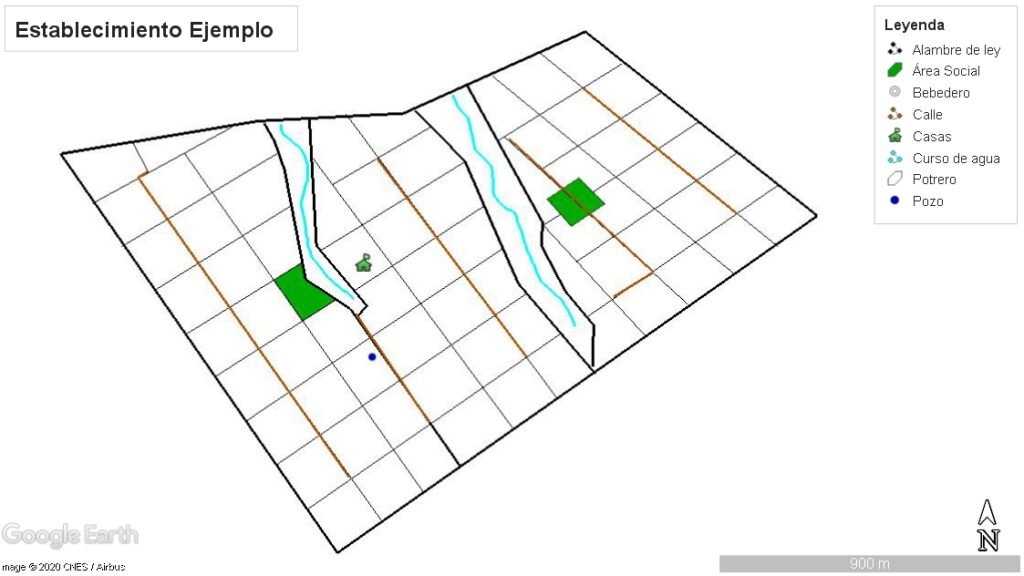Introduction
As in all types of agricultural activity, for the organism of interest to fulfill its vital functions adequately, it is necessary to provide it with the nutrients it needs. Just as we seek to meet the energy and protein requirements of our rodeo, the pasture must also be fertilized, and there are several strategies.
Regarding Voisin Rational Grazing, its basic foundations indicate that the animals must remain in each plot for short intervals of time, thus trying to maintain a high instantaneous stocking rate. In this way they deposit their droppings in the paddock and maintain fertility in the field in a homogeneous way.
Quantification of nutrient production
According to Bavera (2006), an adult European cattle defecates about 15 times a day, producing between 20 and 30 kg of feces. This agrees with the University of Minnesota table below:

Passing the values to the field

If we remember from previous articles, the establishment that we use as an example consists of 172 hectares, divided into 69 plots of between 2 and 2.5 hectares. It has two social areas (or shaded areas depending on the water system used) and is occupied by 150 steers of 350 kg, resulting in a live weight of 52,500 kg.
Carrying out the corresponding calculations, we arrive at the fact that 6,903 kg of nitrogen are being produced annually on the property, 2,106 kg of phosphorus as P2O5 y 4.446 kg de potasio como K2O.
Knowing that the herd of animals stays one day in each plot, we can know how much nutrient is recycled after each grazing. Therefore, those 2.5 hectares per day are fertilized each year with 94 kg of N, 29 kg of P and 61 kg of K.
Fertility transfer and comparison with other systems
The previous data corresponds to animals that always remain in the paddock, but what happens with other activities such as transfers, enclosures in the shade or social areas to drink?
Remembering the article «Water in the paddock»Recalling the article "The water in the paddock", the animals had to walk an average of 970 meters to the social area, at a speed of 1 km/h, where they remained from 10:00 to 16:00. This tells us that the herd spends approximately 1 hour a day on the streets and 6 hours in that sector.
These 7 hours correspond to 29% of the day outside the plot, so it would be expected that around 2,013 kg of N, 614 kg of P and 1,257 kg of K would be lost on roads and social areas.
Finally, we took a system in which the water is in the paddock but even so the animals are confined in the shaded area during the months of October to February from 10:00 a.m. to 4:00 p.m., with a transfer time of one hour. The amount of nutrients left in paths and shade will be as follows: 827 Kg of N, 252 Kg of P and 533 Kg of K
As a summary, we leave below a table that compares the three systems mentioned above in terms of nutrient recycling.

To continue deepening the analysis, we decided to compare this nutrient with commercially used fertilizer sources such as:
- Urea (46 – 0 – 0)
- Superphosphate (0 – 18/20 – 0 + 12S)
- Potassium chloride (0 – 0 – 60)
In the following table, we can see how much fertilizer is equivalent to the recycled nutrient:

If we want to delve deeper into this comparison, we can transform these amounts into monetary value. In the following tables we can see the prices per ton of each fertilizer and the economic value of the recycled nutrient for each hectare of the establishment.


Finally, it can be concluded that nutrient recycling plays a fundamental role in rational grazing. Although it remains to quantify the contribution of organic matter and micronutrients, these values serve to give an idea of the importance of maintaining fertility in the field through the recycling of nutrients.
Practices such as shadow confinement or water systems in social areas reduce recycling due to the transfer of fertility to these sectors. This suggests that this contribution should be made through applications of commercial fertilizers, increasing fertilization costs from 8 to 20 USD/ha (without counting application cost).
Some clarifications
- The data is very variable,since the types of diet interact, which vary in each establishment. The type of pasture provided to the cattle or practices such as supplementation can cause the values to vary significantly.
- It is vitally important to maintain the biodiversity of the soil since it is the microorganisms and insects that break down the organic forms in which the nutrients are released.
- Nutrient values only consider NPK, however the difference is even greater if we consider organic matter and micronutrients.
- In order to simplify the calculations, fertilizers with simple formulations were used, that is, a single nutrient per product.
We thank MarcandoTrillo for the collaboration with the calculations and preparation of tables. MarcandoTrillo por la colaboración con los cálculos y elaboración de cuadros.
